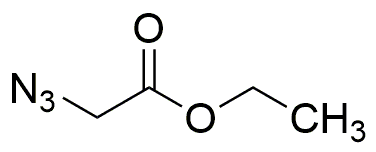Ethyl azidoacetate is widely utilized in research focused on:
- Synthetic Chemistry: It serves as a versatile building block in organic synthesis, enabling the creation of complex molecules through azide-alkyne cycloaddition reactions.
- Pharmaceutical Development: This compound is used in the synthesis of bioactive molecules, aiding in the development of new drugs with potential therapeutic effects.
- Material Science: Ethyl azidoacetate is employed in the production of functional polymers and materials, enhancing properties such as strength and durability.
- Bioconjugation: It plays a crucial role in bioconjugation techniques, allowing researchers to attach biomolecules to surfaces or other molecules for targeted delivery in medical applications.
- Click Chemistry: Its reactivity makes it a valuable participant in click chemistry, facilitating the rapid and efficient formation of stable compounds, which is essential in various research fields.
General Information
Properties
Safety and Regulations
Applications
Ethyl azidoacetate is widely utilized in research focused on:
- Synthetic Chemistry: It serves as a versatile building block in organic synthesis, enabling the creation of complex molecules through azide-alkyne cycloaddition reactions.
- Pharmaceutical Development: This compound is used in the synthesis of bioactive molecules, aiding in the development of new drugs with potential therapeutic effects.
- Material Science: Ethyl azidoacetate is employed in the production of functional polymers and materials, enhancing properties such as strength and durability.
- Bioconjugation: It plays a crucial role in bioconjugation techniques, allowing researchers to attach biomolecules to surfaces or other molecules for targeted delivery in medical applications.
- Click Chemistry: Its reactivity makes it a valuable participant in click chemistry, facilitating the rapid and efficient formation of stable compounds, which is essential in various research fields.
Documents
Safety Data Sheets (SDS)
The SDS provides comprehensive safety information on handling, storage, and disposal of the product.
Product Specification (PS)
The PS provides a comprehensive breakdown of the product’s properties, including chemical composition, physical state, purity, and storage requirements. It also details acceptable quality ranges and the product's intended applications.
Certificates of Analysis (COA)
Search for Certificates of Analysis (COA) by entering the products Lot Number. Lot and Batch Numbers can be found on a product’s label following the words ‘Lot’ or ‘Batch’.
*Catalog Number
*Lot Number
Certificates Of Origin (COO)
This COO confirms the country where the product was manufactured, and also details the materials and components used in it and whether it is derived from natural, synthetic, or other specific sources. This certificate may be required for customs, trade, and regulatory compliance.
*Catalog Number
*Lot Number
Safety Data Sheets (SDS)
The SDS provides comprehensive safety information on handling, storage, and disposal of the product.
DownloadProduct Specification (PS)
The PS provides a comprehensive breakdown of the product’s properties, including chemical composition, physical state, purity, and storage requirements. It also details acceptable quality ranges and the product's intended applications.
DownloadCertificates of Analysis (COA)
Search for Certificates of Analysis (COA) by entering the products Lot Number. Lot and Batch Numbers can be found on a product’s label following the words ‘Lot’ or ‘Batch’.
*Catalog Number
*Lot Number
Certificates Of Origin (COO)
This COO confirms the country where the product was manufactured, and also details the materials and components used in it and whether it is derived from natural, synthetic, or other specific sources. This certificate may be required for customs, trade, and regulatory compliance.

